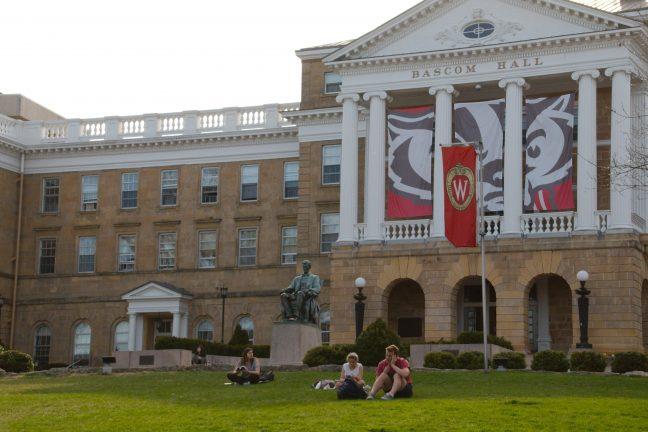UW released a statement March 3 that began permitting gatherings of 50 people indoors and 150 people outdoors on March 8. This move alters the fall semester gathering limits of having no people indoors and 10 people outdoors.
This change followed the March 2 order from Public Health Madison & Dane County that permits up to 350-person indoor gatherings and 500-person outdoor ones. The order cites a lower seven-day COVID-19 case average in the area along with lower ICU bed and hospital occupancy.
Though increasing gathering capacity for events, UW will not increase these limits for class sizes. The statement says these policies apply to “all university-sponsored programs, activities, meetings or gatherings, regardless of their location on or off university property” but “do not apply to formal classroom experiences.”
By only lifting gathering restrictions for campus events, the university is prioritizing more social in-person activities over in-person classes for thousands of students who have mostly taken classes online for more than a year. This discrepancy makes little sense when considering that in-person classes are more valuable and safer than the events the school has now opened up.
A New York Times article highlights how, despite the cheap and easy characteristics of online classes, students are more effective learners in smaller, in-person classes where they can make personal connections with teachers and fellow students. The article mentions that personalized interactions are crucial to student learning and cites a study that found “‘high dosage” tutoring — groups of no more than six students meeting at least four times per week — was one of the most effective ways to improve learning.”
In-person classes are also one of the safest places to gather during a pandemic as they typically have low transmission rates. A recent CDC study found that 3.7% of K-12 COVID-19 cases in Wood County, Wisconsin were associated with classroom transmission and that about 92% of students and staff were compliant with mask-wearing.
This low transmission rate occurs in schools with smaller classrooms, hallways and common areas than a large university like UW, making it likely that transmission rates in our campus lecture halls with masked and socially-distanced students would be lower than 3.7% or almost nonexistent. Mask wearing and social distancing is also easier in a classroom setting because staff can enforce these policies.
While shifting thousands of online classes to in-person settings on campus in the middle of the semester would be logistically difficult, it is not inconceivable and should have been planned for months ago. UW employees and students began receiving vaccines as early as Jan. 5 and the recent order cites “continued vaccinations” as a main reason for loosening restrictions, but the school failed to create a plan that would phase in in-person classes alongside vaccinations.
UW administrators should have used the months over winter break to assign classroom spaces as a backup for every class to use in the case that an order like this one was passed, and planned to re-hire any maintenance workers who would enable classrooms to reopen.
The school’s inability to put students back in classrooms when they are legally and financially able to do so is concerning. Administrators are not pushing hard enough to return our campus to in-person, meaning they are disconnected from student demands or just leaving off the logistics of reopening until fall 2021, which is when the UW System is trying to have 75% of classes held in person.
The ability to meet other students in one class per week would have a beneficial impact on our mental health and learning abilities. Associate Director of Research and Evaluation at consulting firm Ithaka S+R Rayane Alamuddin said in an article that students rely on in-person interactions to learn.
“Students talked a lot about really missing being in person with their classmates,” Alamuddin said. “They miss the [relationships] they make in the context of their college education specifically, because not only does it make them excited about learning and hold them accountable and motivate them to stay engaged in school, but they also actually learn a lot more.”
It’s also possible the university is under the impression that students aren’t as desperate to return to in-person classes this semester as we are. Organizations that have lobbying power with the university like Associated Students of Madison have played a role in restricting in-person classes. ASM called for a move to “fully online classes, with only rare exceptions” in a statement to UW in the fall despite strong evidence that in-person classes are largely safe from COVID-19.
Online classes can lead students to mental exhaustion and may lead them to drop out from education altogether. A UNICEF press release said that marginalized children are most likely to drop out of online school and “risk losing their learning, support system, food and safety” when unable to access classrooms. The release cites a recent global study in 191 countries that showed no correlation between schools and community COVID-19 infection rates in arguing that schools should reopen.
UW has been inconsistent in managing the pandemic for nearly a year now, ranging from their shortening of campus union and library hours to dorm lockdowns. While it is fully excusable for some logistical problems during an unprecedented pandemic, switching classes from online to in-person learning should not be as difficult as the administration makes it appear.
In-person classes are necessary to learning and what every student at UW pays for. If we can now host 50-person gatherings on campus, there is no reason why we can’t have in-person classes where COVID-19 transmission is low. This discrepancy shows there is a broader disconnect between student demands and the school administration policy, and we must reevaluate how students and administrators communicate.
Will Romano (wromano@wisc.edu) is a freshman studying economics and journalism.


